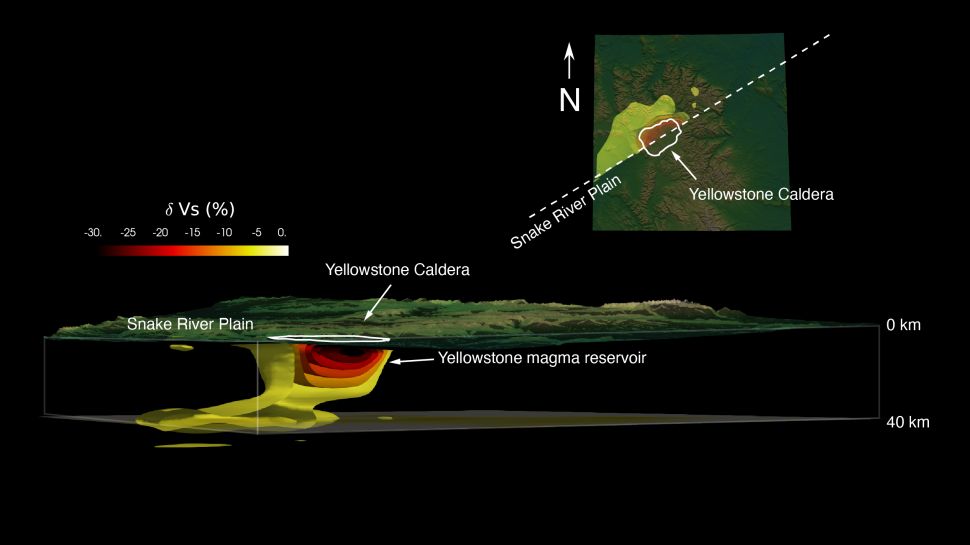The mantle hotspot now under Yellowstone is thought to have been the source of the voluminous Columbia River Basalts that erupted from 17 to 6 million years ago as the North American continent passed over the hotspot, and that now underlie much of the path of the Ice Age Floods. During and since that time the hotspot cut a long and explosive path from the Oregon/Nevada/California border across the Snake River Plain, but ongoing research appears to show it to be fairly stable for at least our brief geologic time.
A new study has found the amount of melted rock beneath Yellowstone’s supervolcano is far higher than previous estimates. Scientists have worked out the consistency of the magma under the Yellowstone caldera using seismic waves — and the reservoir is filled with “mush” that doesn’t pose an imminent eruption threat. While researchers say there is no sign of an imminent eruption, the discovery provides a more detailed view of what’s going on in the enormous magma chamber that sits beneath the national park.
Far from a smooth blend of molten rock, magma reservoirs contain a large amount of solid rock, semi-liquid crystals, gasses and other volatile substances. This “magmatic mush” is highly dynamic but tends to burst out from deep underground when the proportion of liquid — or melt — crosses a certain threshold. Previous work suggests that eruptions typically occur when at least 50% of the space in the upper magma reservoir — a layer of flattened pockets of magma stacked on top of each other — is filled with melt.
The magma reservoir beneath Yellowstone volcano consists of two chambers — a shallow reservoir near the surface that’s around 55 miles (90 kilometers) long and 25 miles (40 km) wide, and a deeper chamber that is about 4.5 times larger. While the deeper reservoir contains about 2% melt, the upper chamber contains far more: A study published in Science in December 2022 put the proportion of melt between 16% and 20%.

Now, Sin-Mei Wu, a geophysicist and postdoctoral researcher with the Swiss Seismological Service at the Federal Institute of Technology (ETH) in Zurich, and colleagues have found the percentage is much higher. The team used seismic wave data to assess the texture and composition of the upper magma reservoir, which is about 3 miles (5 km) deep at Yellowstone. The results, published June 8 in the journal Earth and Planetary Science Letters, indicate the upper chamber consists of 28% melt — 8% to 12% more than the 2022 estimate, which was found with different methods, Wu said.
“What we found is that the portion of liquid phase is not enough to have an imminent eruption,” Wu told Live Science. “Although we found a much higher portion of liquid than what was previously found, it’s still only up to 28%. So, to the best of our knowledge, Yellowstone will not have an imminent eruption.”
Working out the proportion of liquid in magma reservoirs could help scientists evaluate the risk of volcanic eruptions elsewhere. “It’s important to understand the eruption potential, maybe not for Yellowstone so far, but you can apply the same methods to other magma systems that are more prone to eruption and to some that are already erupting,” Wu said.
The methodology used for the study is “revolutionary in the detail and resolution it allowed for,” said Michael Poland, a research geophysicist and scientist-in-charge at the Yellowstone Volcano Observatory.
The magma at Yellowstone and in other magmatic systems is like “mush,” Poland told Live Science in an email. “We often refer to ‘magmatic mush’ to convey a sense that it’s not a 100% molten ball, but also contains a lot of solid material — in the case of Yellowstone, way more solid than liquid material,” he added. “Maybe like a really thick lentil soup.”
Despite recent breakthroughs, scientists can’t be sure what exactly lurks beneath the supervolcano, Wu said. “We are looking forward to some joint interpretation with other geophysical data to find out, for example, if we only have melt or if there is gas, volatiles, or something else that will help us understand the eruption dynamics.”
From an article in Live Science by
